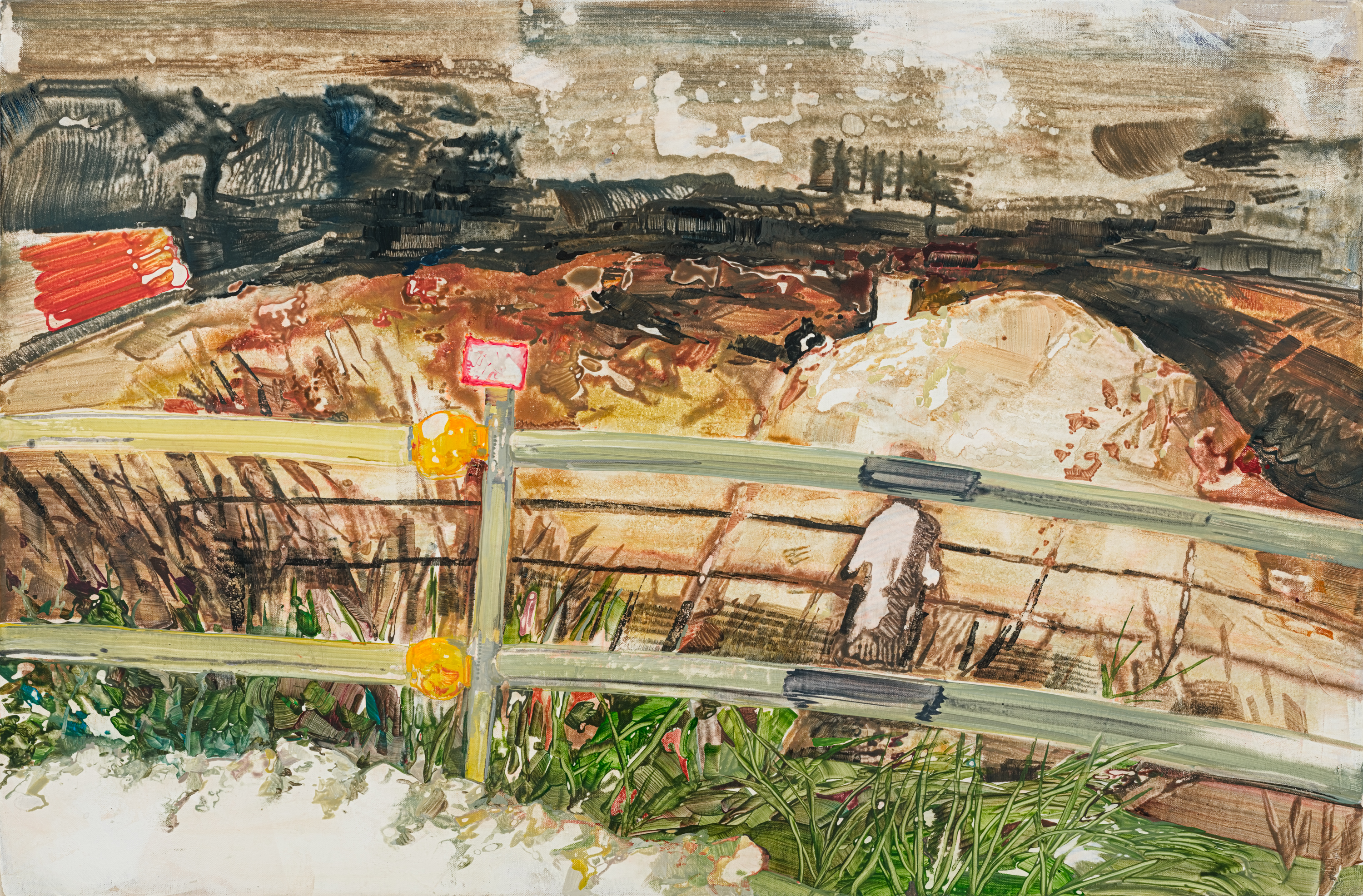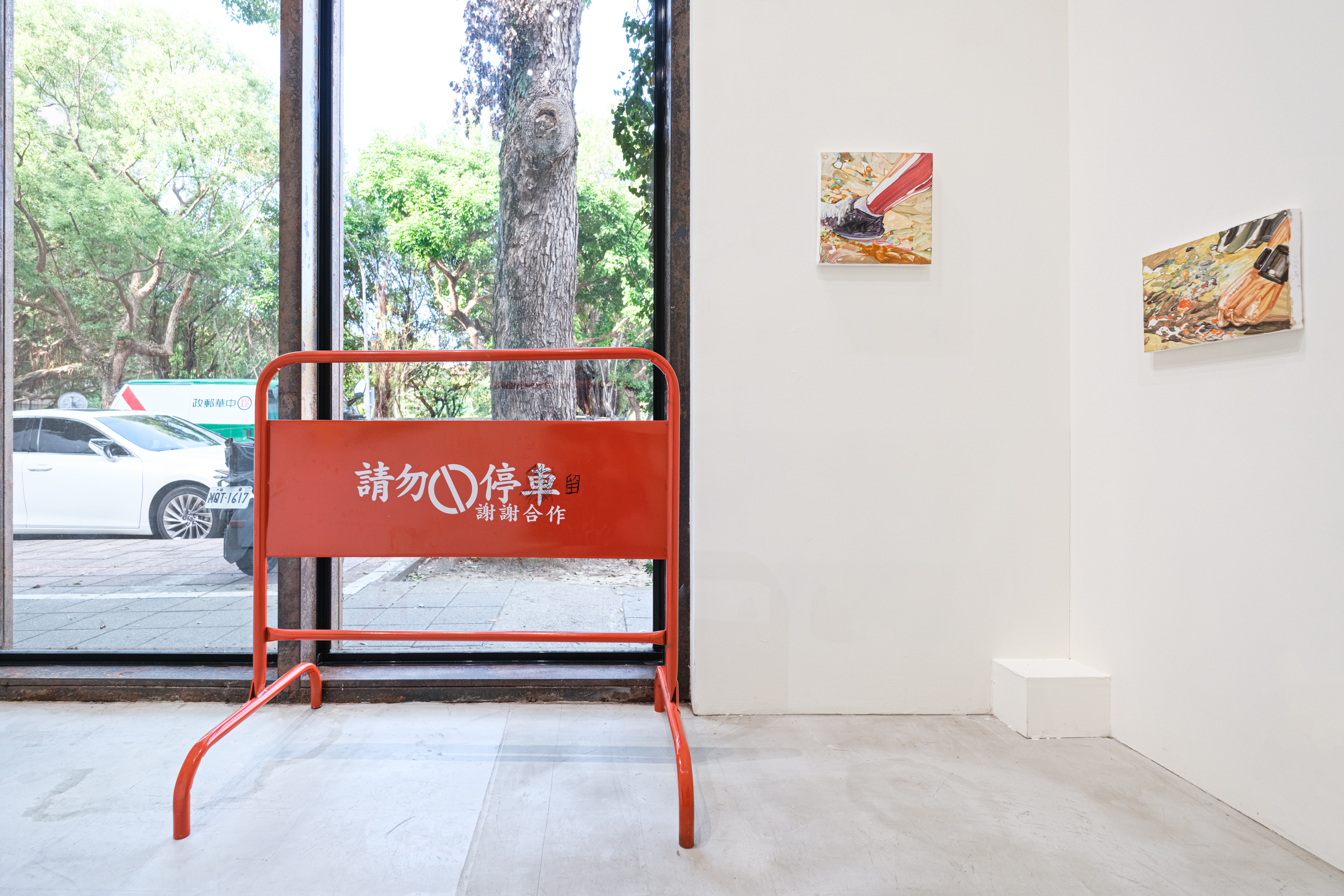FU Ning – Red Eyes when I miss you
FU Ning – Red Eyes when I miss you
2023.November.11 — December.17
A motorcycle rearview mirror, weeds, swaying grass in the wind, the speed at which one falls in love, boxes, crates…… How do these “objects” transition into “evidence”? Especially those mundane objects. These “objects,” collected through “paintings,” serve as the background noise of life, softly lingering within FU Ning’s solo exhibition “Red Eyes when I miss you” at Hiro Hiro Art Space, from November 11, 2023, to December 17, 2023.

Falun Gong, 2023
Acrylic on canvas
72.5 X 50 cm
Art critic: HU Jungyi
FU Ning’s paintings commence with examining the generation mechanism of contemporary image, integrating ostensibly mundane and inconsequential visual elements from daily life, creating a diary-like painting exploration. Through painting, she contemplates and reflects on the challenges faced by contemporary art: the rapid and excessive production of images. The constant updating and proliferation of images occur so hastily that they often struggle to capture focus and attention. People sometimes find the overwhelming deluge of visual stimuli suffocating and ineffective, leading creators to feel a sense of frustration and powerlessness in the visual innovation when creating.
In FU Ning’s artistic expressions, one can see her employing vibrant hues and concise brushstrokes to depict powerful image forms, reminiscent of snapshots captured by an instant camera. This reflects the direct impressions of things, conveying a “fresh” texture in the visual representation. From another perspective, there are occasions when she exerts more effort to delve into the “raw” taste of painting, experiencing the medley of images into indistinguishable shapes that coexist.

She applies extruded pigments, directly blending colors on the canvas with an unrestrained and spontaneous expressiveness, resulting in a vigorous and pungent portrayal. Alternatively, she sometimes adopts a method where the canvas is not fully primed, exposing the raw texture of the fabric. Sections of pigment layers are selectively removed, harmonizing with earthy or organic hues. With a moist brush layering strokes of leaves, clusters of grass, exterior walls of houses, or skin, they together evoke a unique “gustatory sensation” in painting.
It must be emphasized that the “flavor” encapsulated in her paintings is not purely pleasant, satisfying, or palatable; rather, it exudes a raw and piquant essence, redolent of the untamed and sharp qualities found in the wilderness, or the sweet-savory and bitter taste of soy sauce. To further describe this sensory state, envision a white porcelain dish with fresh green wasabi soaking in soy sauce yet to be evenly stirred. The horseradish is freshly ground, mixing with the smell of soy sauce’s saltiness and a hint of bitterness lingering in the ambient space. Lower your gaze and observe the horseradish paste; its pungency travels up to your sinuses. Then, take sips of wheatgrass juice—the whole experience induces a dizzying sensation at the crown of the head.
Transitioning to another physiological realm, this gustatory association is analogous to the interplay between sensory fatigue and a sudden awakening sensation while drawing in a breath of crisp, cold air. From any perspective, FU Ning’s works embody an internal “self-repulsion,” this contradictory repulsion subsequently reaches a certain state of “integration” on the visual interface she unfolds. It is an integration that is not uniform, a blending that is not united. Images, pigments, and perceptions, with a subtle trace of lingering vitality, find a way to bridge the gaps between each other.
If we consider “mingling” as a kind of outdoor feast which triggers the taste-related associations in her painting, it represents the phenomenon of contemporary images, so rapid that swift replacement can lead to visual indigestion. Moreover, this complex yet not entirely harmonious sensory analogy implies that deciphering the content of the images is not the foremost concern when viewing Fu Ning’s paintings; instead, her creation focuses on the depiction and restoration of states generated by the act of “mingling.”
The life of painting is founded on experiential understandings of the everyday. Postulating that the “isolated existence” of entities is not possible, and that “mixture” is the norm, then the layers, knots, and self-repulsion accentuated in her paintings are intended to respond to the “fractalization” of images, the disorder of information, and the self-perplexity and quandaries that painting confronts in the contemporary context, where profound meaning is challenging to derive.

In Hiro Hiro Art Space’s exhibition “Red Eyes when I miss you,” FU Ning not only continues her exploration of fragmented contemporary images but also delves into a retrospective organization drawn from her personal past experiences in a romantic relationship, showcasing an “impressionistic portrayal” rooted in imagination. Perhaps the symbolic extension of this love experience in her creations inevitably brings back certain poignant memories, persistently probing at the heart’s demons. Yet, in the next moment, as time goes by, the once-thought-departed melancholic memories unexpectedly come rushing back! Much like the mingling layers on her painting’s surface, seemly balanced but, in fact, conceal an inherent force of repulsion within. In relationships, if one’s individuality had been suppressed, it may, at some point in the future, resurge with greater tension. Paradoxically, this resurgence becomes a vibrant force in painting, infusing FU Ning’s artistic endeavors with different energy.
FU Ning’s painting techniques and experiments in this exhibition resonate with her unsuccessful romantic relationship. To portray the disintegration and subsequent reconstruction of memories, she tears layers of pigment from the canvas, obtaining fragments of either brittle or soft images. The areas stripped away reveal the bare, sepia-toned canvas underneath, with some other uneven peeling surfaces resketched using pencil and charcoal. It is akin to a journey of recovery, where one endeavors to forget chaotic memories, while feeling the need to engage in something to nurture the “inner self” after the passage of time.
FU Ning’s bold strokes, occasionally unleashed with sweeping gestures, cleave open the ruptures in the images, threading through the semi-figurative subjects and spaces. In other instances, strokes intertwine like densely packed dots, resembling soil turned over and over. Stirring, dragging, stretching, and fluidly wielding the brush, FU Ning instills tension in her entire painting language, with primarily punctuated expressions. In contrast, the unmixed bright hues applied with broad strokes attempt to harmonize with the stones and soil that emerge after the turnover.
These heterogeneous visual languages, material handling, the arcs traversing the canvas, segmentation, overturning of canvas or pigment layers, priming, and blending techniques—all constitute material explorations can be interpreted as FU Ning’s effort to employ distinct practice and rhythm, aiming to break away from the banality of images. In the mingling, it forms a metaphorical depiction of the fragmented contemporary visual experience.
Swipe→
Works















About Artist

FU Ning, born in 1995 in Taoyuan, Taiwan, graduated from the Painting Department of Taipei National University of the Arts. She has been awarded the 2024 Tainan New Art Award, the 2022 SANCF Award, the 2021 CTBC Painting Prize (Honorable Mention), nominated for the 9th Grand View Emerging Artists Award, selected for the 2021 Taipei National University of Contemporary Art Prize, received the 13th and 15th Long Yen Art Foundation Art Scholarship, and won the first prize in the 2015 Bright Star Project.












